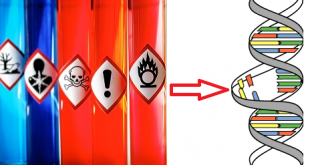The second topic of second year Fundamental Genetics syllabus is Exceptions of Mendelism. So by the title of the article you may have understood that in this article we are going to discuss Exceptions of Mendelism.
In this article we will disscuss 1st law. 1st law is divided into
- Incomplete dominance,
- Co-dominance,
- Lethal gene.
Incomplete Dominance
- Pattern of gene expression in which the phenotype of a heterozygous individual is intermediate between those of the parents.
- Cases in which one allele is not completely dominant over another.
- Example : Snapdragon
Best safe and secure cloud storage with password protection
Get Envato Elements, Prime Video, Hotstar and Netflix For Free
Best Money Earning Website 100$ Day
#1 Top ranking article submission website
Carnations
Exceptions of Mendel’s Law
With incomplete dominance, a cross between organisms with two different phenotypes produces offspring with a third phenotype that is a blending of the parental traits.





| Note:
For example, in a particular breed of chicken called Andalusians, black and white parents produce F1 hybrid offspring, called “blues,” with grayish-blue feathers (Figure 10-9). Because neither the black nor white allele is dominant, capital and lowercase letters are not used to represent them. Instead, a C for “color” is paired with a superscript B for “black” or W for “white” to represent the two alleles. A heterozygote chicken has one of each allele, CBCW, and is blue in color.’ Although the F1 phenotypes are intermediate, this inheritance pattern does not support the blending hypothesis. This is because the parent phenotypes can reappear in the F2 generation. In the chicken example, the predicted phenotypes in the F2 are 1 black : 2 blue : 1 white. that 1 : 2 : 1 is also the ratio of genotypes. |
 CoDominance
CoDominance 
- Co means together and dominant means equal in dominance.
- Alleles are approximately equal effect in individuals; alleles are equally detectable in individuals.
- Phenotypes for both alleles are exhibited in the heterozygote.
- The hybrid shows neither neither of the parent’trait, instead, a third, different phenotype.
- Examples of this blood types; ABO, iAiB.
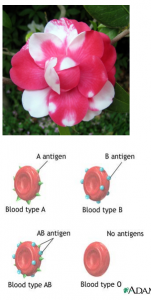
CoDominance
- Neither allele is dominant
- Heterozygote expresses both alleles equally
- In flowers a red and white flower
- ABO blood groups
II. What are multiple alleles?
A. sometimes there are more than two alleles possible for a trait.
- However, each individual organism will still only have two alleles (one from Mom and one from Dad) even if there are more.
- Examples: blood types, hair color and eye color.
B. This can lead to more possible genotypic and phenotypic ratios.
C. Blood Types
1. Human blood type is good example of BOTH multiple alleles and codominance.
- There are 3 possible alleles and two of them act dominant (A and B are dominant while O is a recessive allele.)
2. Blood Type Alleles
- Type A: Causes cells to make protein A for the surface of the RBC’s.
- Type B: Causes cells to make protein B for the surface of the RBC’s.
- Type O: Causes cells to make no protein for the surface of the RBC’s.
3. Both A and B alleles are DOMINANT over the O allele because if any A or B allele is present., they will be expressed and the A or B proteins will be made.
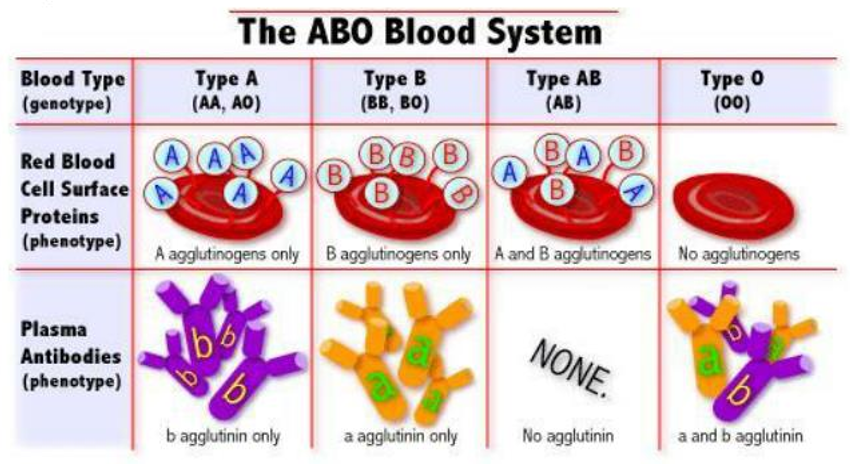
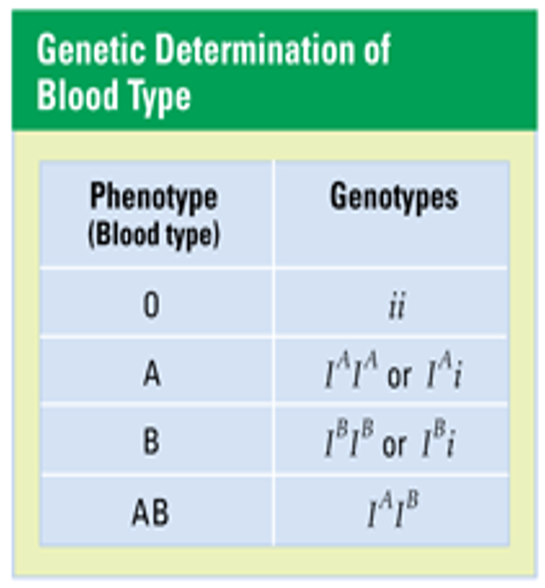
Qustions:
- What is the probability of a child having type AB blood if one of the parents is heterozygous for A blood and the other is heterozygous for B blood?
- What other genotypes are possible for chlidrens of those parents?
Solution:
When parents holding heterozygous genotype for bllod type A and bllod type B were crossed, the possible genotypic combination could be observed by drawing a punnet’s square as shown bellow.
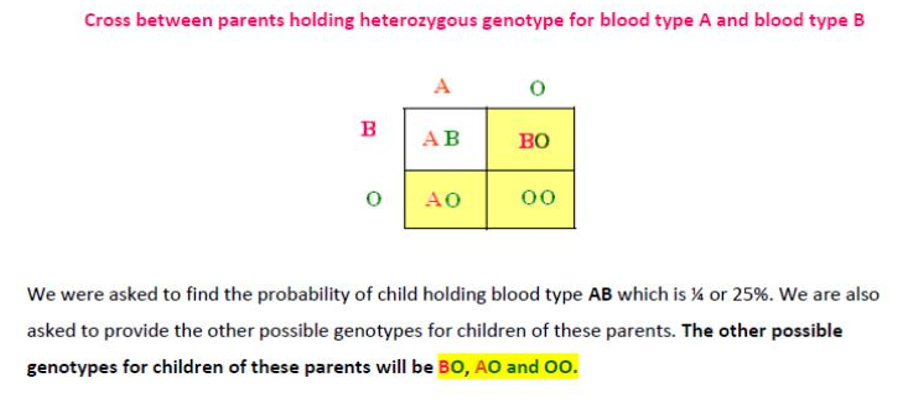
Incomplete Dominance V. codominance
Incomplete dominance: One allele is only practically dominant to the other; the heterozygote exhibits a phenotype that is intermediate relative to the dominant and recessive phenotypes.
- Example: Flower color in Carnation.

– Homozygous dominant (AA) = RED phenotypes
– Homozygous recessive (aa)= White
– Heterozygous (Aa) = PINK
- Codominance: Both alleles are are equally dominant and both alleles are visible in the hybrid genotype
- Example: Feather color in chickens.
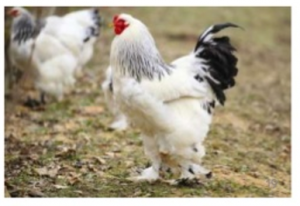
– Homozygote 1(F1 F2) = BLACK feathers
– Homozygote 1 ( F1 F2)= WHITE
– Heterozygote (F1 F2)= BLACK and WHITE pattern
Introduction
- “Allele which cause an organism to die is known as lethal allele.“
- Certain genes are absolutely essential for survival. Mutation in these genes creates lethal allele.
- Lethal alleles are dominant or recessive.
- Fully dominant lethal allele kills organism in both homozygous and heterozygous condition.
- Certain lethal alleles kills organisms in homozygous condition only.
History
- Lethal genes were first discovered by Lucien Cuénot while studying the inheritance of coat colour in mice.
- He expected a phenotype ratio from a cross of 3 yellow:1 white, but the observed ratio was 2:1.
- Allele was lethal in homozygous dominant condition.
Lethal Gene
Some genes – cause death during early stage of development (before sexual maturation).
Types of lethal alleles
- Lethal alleles falls into four categories.
1. Early onset- lethal alleles which result in death of an organism at early stage of life for example during embryogenesis.
2. Late onset- lethal allele which kills organism at their final stage of life are known as late onset allele.
3. Conditional- lethal allele which kill organism underbcertain environmental conditions only.
e.g. temperature sensitive alleles kills organism at high temperature. But they don’t kill any organism at low temperature.
4. Semi lethal – Lethal allele which kill only some individuals of the population but not all are know as semi lethal.
LETHAL MUTATIONS
- Alleles that cause an organism to die only when present in homozygous condition are called lethal alleles.
- Lethal alleles are often inherited as recessive mutants, recessive lethal alleles that kill only homozygotes.
- Lethal alleles are often detected as distortions in segregation ratios, where one or more classes of expected progeny are missing.
- Example coat colour gene in mice.
- 3:1 (viable : dead)
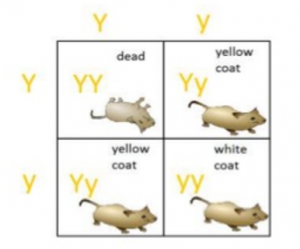
b) Lethal allele
- Some genes – cause death during early stage of development (before sexual maturation).
- A fully dominant lethal allele arise by mutation froma wild type allele.
- Dominant lethal genes lost from the heterozygous
- organism called as gene erosion.
- Most of all lethal genes are recessive (death only homozygous).
- There are two types of lethal alleles.
1. One that has no obvious phenotypic effect in heterozygous
a. Mice coat colour
Dominant homozygous causes death during embryonic stage.
b. Aurea gene in Antirrhinum majus
It produces yellow leaf due to lack of chlorophyll in heterozygous.
c. Dexter gene in cattle.
d. Achondroplastic dwarfness in man.
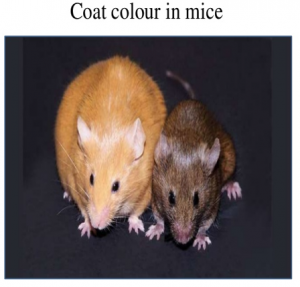 |
 |
2. One that exhibit a distinctive phenotype when heterozzvgous.
The amount of chlorophyll in snapdragons is controlled by a pair of alleles C1 and C2.
One of which C2 exhibits lethal effect when homozygous and a distinctive colour phenotype when heterozygous.
Thus with regard to colour these alleles are incomplete dominant.
However, with regard to viability the C2 allele is fully recessive that the C2 allele only causes death when C1 is absent.
Snapdragon Plant
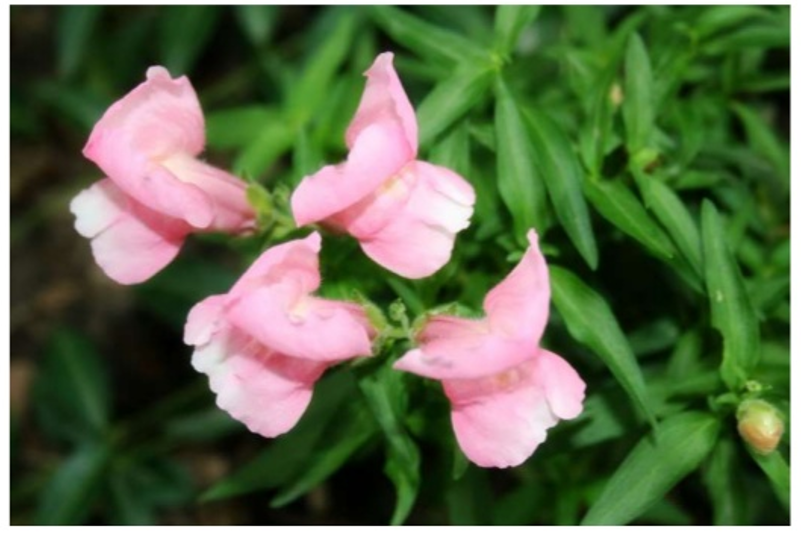
We have finished part (a) in this article. To know more you have to find the article named Exceptions of Mendelism part II.
 Plantlet The Blogging Platform of Department of Botany, University of Dhaka
Plantlet The Blogging Platform of Department of Botany, University of Dhaka




